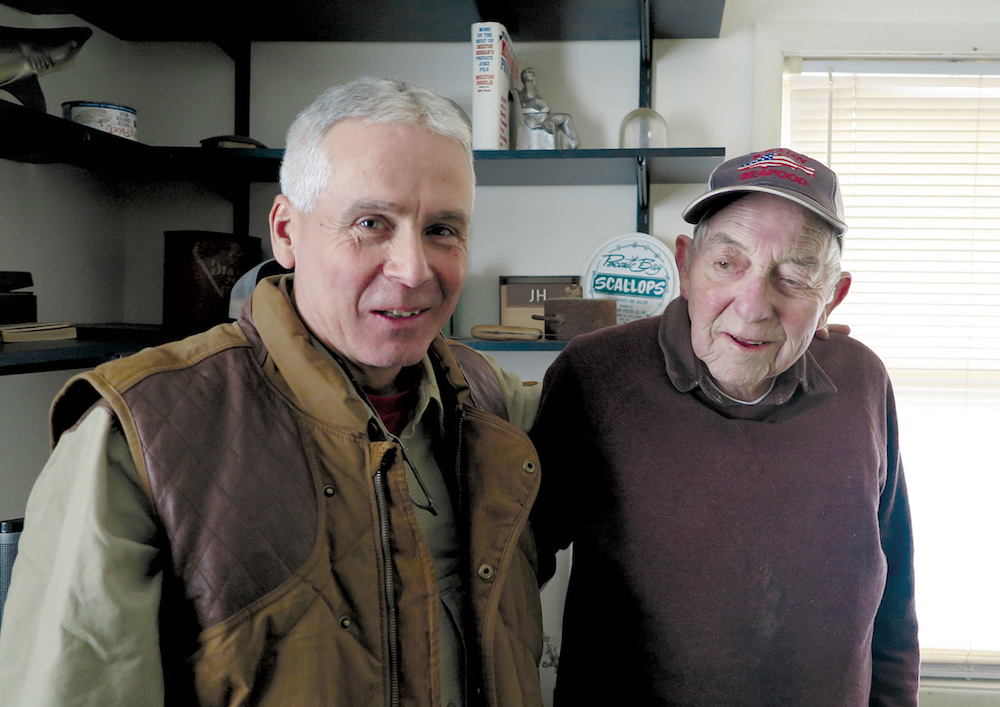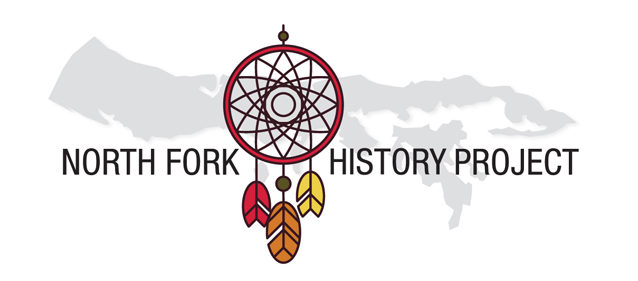North Fork History Project: The scallop industry has a rich past on eastern Long Island

One offshoot of running a company that’s been in the shellfish business for 90 years is aquatic and historical clutter. Ken Homan’s office at Braun Seafood in Cutchogue is an archive of shellfishing ephemera and Native American history, a collection that feels like a room at the American Museum of Natural History.
Ken’s father, 90-year-old Jim Homan, who headed the company for over 50 years, is a firsthand witness to the 20th-century history of scalloping on the East End. Mr. Homan took over an oyster shack started in 1928 by George Braun and turned it into one of the largest seafood distributors on the East End. Peconic bay scallops had a lot to do with that.
“The oyster business was going to hell,” said Jim Homan. “I wouldn’t say we ‘got into’ scallops. You only get into scallops when the scallops are here to get into. There were a few in the late ’50s, and they really hit ’em in the ’60s and the ’70s,” he said. “We used to fly them out — a fleet of planes going up to New England, with 13 five-gallon cans on a single engine and 26 cans on double-engine plane.”
Foraged food as economic engine
Bay scallops have been an important food on eastern Long Island as long as there have been creatures to gather and eat them. The archaeological evidence that Late Woodland period Native Americans ate scallops is extensive. Large numbers of scallop shells have been discovered in middens on Robins Island, Shelter Island, Orient and other sites.
The first evidence of commercial scalloping on the North Fork comes from newspaper accounts of local people in 1857 observing a boat from Connecticut harvesting scallops just northeast of Robins Island. By December 1873, commercial scalloping was local and a Southold newspaper reported that scallops from New Suffolk were taken to Port Jefferson by wagon and sold for 3 cents per quart. In the 1880s, a U.S. Fish Commission Report described scallop shacks in New Suffolk. “Piles to the height of 8 or 10 feet and covering a quarter of an acre were alongside the opening houses,” the report reads.
On Dec. 2, 1884, Charles Congdon of Shelter Island sold several gallons of scallops to John Elsey, a New York seafood distributor. The sale took place just after the railroad linked New York City and Greenport in July 1844, establishing a vital link in the supply chain. Now there was same-day delivery of bay scallops to the enormous New York market.
For the next 100 years, scalloping was an important factor in the East End economy. A newspaper account in the archives of Oysterponds Historical Society describes a bed of scallops found off Bayview in 1899, from which baymen took anywhere from 30 to 60 bushels a day. In February 1900, thousands of bushels of scallops washed up on the south shore of Peconic Bay. “The baymen shoveled them like pebbles and carried them off in double arm loads,” reads a handwritten account in the society’s CA Wood Collection.
Jim Homan remembers selling bay scallops to many New York restaurants during the 1960s, including Sardi’s, the 21 Club and Luchow’s. They were often fried, sometimes “half and half” — a mixed fry of oysters and scallops — or served broiled with bacon. On a Tuesday in February 1965, Luchow’s offered “Bay Scallops à la Poulette en Casserole with Long Grain Rice Pilaff” for $2.65, according to a menu in the collection of the New York Public Library.

How to get ‘a mess of scallops’
Gathering scallops decades ago involved a bayman pulling a dredge — an iron frame with a bag attached — along the bottom of the bay from a sailboat, at least until outboard motors became common in the late 1950s.
Some baymen working today still use dredges handmade by Paul “the Blacksmith” Nossolik, who worked for 60 years near the waterfront in Greenport. Keith Clark of Shelter Island remembers visiting Mr. Nossolik in his shop. “His fingers were black and there was soft coal all around the shop up to your knees,” he said. “You came out of there smelling like a smoked eel.”
Hoot Sherman, Shelter Island supervisor in the early ’80s, said the opening of scallop season completely dominated the life of the town in the days when the harvests were huge. “Every year for the first weeks after opening day, I couldn’t find anybody to work the ferry,” he said. “They were all out scalloping.” Children missed school to go scalloping and everyone who could hold a scallop knife spent afternoons opening at one of the many scallop shacks on the island.
Bay scallops have to be opened the day they are taken because, unlike oysters, their shells don’t close and they spoil quickly. “If we had scallops like in the ’60s, we wouldn’t have enough baymen to catch them,” Jim Homan said. “And there wouldn’t be any way to open them. Then, everyone had an opening shop.”

A brush with extinction
In 1985, a devastating die-off caused by harmful algae blooms signaled the beginning of a death spiral that brought the Peconic Bay scallop close to extinction. Since baymen take adult scallops at the end of their life cycle, overfishing has never been a significant factor in the decline of the bay scallop population. The problem was fueled by water pollution, an increase in predators and environmental changes that affected the scallop’s habitat. In 1996, the entire annual scallop harvest for New York State was nine bushels.
Scallop season, which had opened in September for as long as anyone could remember, was pushed back to the first Monday in October and then, in 2005, to the first Monday in November to allow the few remaining scallops more time to spawn. In 2006, a reseeding program headed by Stephen Tettelbach at Long Island University began to support wild bay scallop populations by planting millions of larval scallops in the Peconic estuary.
Jim Homan has a sure-fire method to assess the health of the bay scallop populations, based on the fact that the sweet morsels are as tempting to seagulls as they are to chefs.
“When you go past the floating docks and you see them all full of scallop shells, you know there are scallops in the creek,” he said.
While not back to the bountiful harvests of the ’70s and early ’80s, scallop numbers have increased over the last decade, and bay scallops are still an important part of many a North Fork holiday table. Ken Homan, who has a keen interest in Native American history, said he likes to make a stuffing with bay scallops, a Thanksgiving tradition that’s probably a lot closer to what Native Americans and colonists were actually eating than roasted turkey.
Top photo caption: Ken Homan (left) and his father, Jim, at Braun Seafood in Cutchogue. (Charity Robey photo)









